Dark Current Noise Correction Method Based on Dark Pixels for LWIR QWIP Detection Systems
Abstract
:1. Introduction
2. Dark Current Noise Correction Method Based on Dark Pixels
2.1. Definition and Properties of Dark Pixels
2.2. Preparation of the Dark Pixels QWIP
2.3. LWIR QWIP Detection System Design
2.4. Dark Current Noise Correction Model
2.4.1. QWIP Photoelectric Conversion Model
2.4.2. The Mechanism of Temporal Noise Generated by Dark Current Fluctuations
2.4.3. Acquisition and Pre-Processing of Feature Data
2.4.4. Correction Method
3. Dark Current Noise Correction Experiment for the LWIR QWIP System
3.1. The Validity of Dark Pixels
3.2. Dark Current Noise Correction Experiment
4. Conclusions
Author Contributions
Funding
Institutional Review Board Statement
Informed Consent Statement
Data Availability Statement
Conflicts of Interest
References
- Liu, J.; Xiao, L.; Liu, Y.; Cao, L.; Shen, Z. Development of long-wavelength infrared detector and its space-based application requirements. Chin. Phys. B 2019, 28, 028504. [Google Scholar] [CrossRef]
- Huang, W.; Ji, H. Effect of environmental radiation on the long-wave infrared signature of cruise aircraft. Aerosp. Sci. Technol. 2016, 56, 125–134. [Google Scholar] [CrossRef]
- Lu, Y.; Shao, Q.; Yue, H.; Yang, F. A review of the space environment effects on spacecraft in different orbits. IEEE Access 2019, 7, 93473–93488. [Google Scholar] [CrossRef]
- Hołyńska, M.; Tighe, A.; Semprimoschnig, C. Coatings and thin films for spacecraft thermo-optical and related functional applications. Adv. Mater. Interfaces 2018, 5, 1701644. [Google Scholar] [CrossRef]
- Bonnici, M.; Mollicone, P.; Fenech, M.; Azzopardi, M.A. Analytical and numerical models for thermal related design of a new pico-satellite. Appl. Therm. Eng. 2019, 159, 113908. [Google Scholar] [CrossRef]
- Sharma, A.; Sridhara, N. Degradation of thermal control materials under a simulated radiative space environment. Adv. Space Res. 2012, 50, 1411–1424. [Google Scholar] [CrossRef]
- Chi, G.C.; Liu, X.D.; Wen, J.G.; Lu, X.C. Dynomic environment adaptability analysis and verification for a rotary and integral Stirling cryocooler. Cryog. Supercond. 2017, 45, 20–24. [Google Scholar]
- Huang, F.; Shen, X.; Li, G.; Wang, G.; Zhao, Z. Influence of background radiation on space target detection in the long wave infrared range. Opt. Eng. 2012, 51, 086402. [Google Scholar] [CrossRef]
- Ye, Z.; Li, F.H.; Wang, J.D.; Chen, X.; Sun, S.H.; Liao, Q.J.; Huang, A.B.; Li, F.; Zhou, S.M.; Lin, J.M.; et al. Recent hotspots and innovative trends of infrared photon detectors. J. Infrared Millim. Waves 2022, 41, 15–39. [Google Scholar]
- Bhan, R.K.; Dhar, V. Recent infrared detector technologies, applications, trends and development of HgCdTe based cooled infrared focal plane arrays and their characterization. Opto-Electron. Rev. 2019, 27, 174–193. [Google Scholar] [CrossRef]
- Gunapala, S.; Bandara, S. Quantum Well Infrared Photodetector (QWIP) Focal Plane Arrays. In Semiconductors and Semimetals; Elsevier: San Diego, CA, USA, 1999; Volume 62, pp. 197–282. [Google Scholar]
- Rogalski, A. Quantum well photoconductors in infrared detector technology. J. Appl. Phys. 2003, 93, 4355–4391. [Google Scholar] [CrossRef] [Green Version]
- Tidrow, M.Z.; Beck, W.A.; Clark, W.W., III; Pollehn, H.K.; Little, J.W.; Dhar, N.K.; Leavitt, R.P.; Kennerly, S.W.; Beekman, D.W.; Goldberg, A.C. Device physics and focal plane array applications of QWIP and MCT. In Proceedings of the Photodetectors: Materials and Devices IV, San Jose, CA, USA, 27–29 January 1999; SPIE: Bellingham, WA, USA, 1999; pp. 100–113. [Google Scholar]
- Ryzhii, V.; Khmyrova, I.; Ryzhii, M.; Mitin, V. Comparison of dark current, responsivity and detectivity in different intersubband infrared photodetectors. Semicond. Sci. Technol. 2003, 19, 8. [Google Scholar] [CrossRef]
- Levine, B.F. Quantum-well infrared photodetectors. J. Appl. Phys. 1993, 74, R1–R81. [Google Scholar] [CrossRef]
- Ohnakado, T.; Ueno, M.; Ohta, Y.; Kosasayama, Y.; Hata, H.; Sugino, T.; Ohno, T.; Kama, K.; Tsugai, M.; Fukumoto, H. Novel Readout Circuit Architecture Realizing TEC-Less Operation for SOI Diode Uncooled IRFPA. In Infrared Technology and Applications XXXV; SPIE: Bellingham, WA, USA, 2009; pp. 302–311. [Google Scholar]
- Li, X.Y.; Li, N.; Xu, J.T.; Chu, K.H.; Xu, G.Q.; Wang, L.; Zhang, Y.; Zhu, L.Y.; Wang, J.Q.; Lu, W. GaAs/AlGaAs QWIP IRFPA for 10.55 μm long wavelength. Infrared Laser Eng. 2020, 49, 77–82. [Google Scholar]
- Zhang, W.K.; Chen, H.L.; Ding, R.J. Long wavelength infrared readout circuit with background suppression function. Infrared Laser Eng. 2021, 50, 20200266. [Google Scholar] [CrossRef]
- Zhang, C.J.; Zhang, H.; Chang, Y.G.; Chen, C.C. A review of radiometric calibration methods for optical remote sensors of Landsat series satellites. J. Remote Sens. 2015, 19, 719–732. [Google Scholar]
- Zhao, Y.H.; Wang, H.; Li, Y.F.; Li, Y.; Zhang, X.X. High-precision radiometric calibration techniques for long-wave infrared space optical remote sensors. J. Remote Sens. 2021, 25, 1646–1654. [Google Scholar]
- Masek, J.G.; Wulder, M.A.; Markham, B.; McCorkel, J.; Crawford, C.J.; Storey, J.; Jenstrom, D.T. Landsat 9: Empowering open science and applications through continuity. Remote Sens. Environ. 2020, 248, 111968. [Google Scholar] [CrossRef]
- Reuter, D.; Richardson, C.; Pellerano, F.; Irons, J.; Allen, R.; Anderson, M.; Jhabvala, M.; Lunsford, A.; Montanaro, M.; Smith, R.; et al. The Thermal Infrared Sensor (TIRS) on Landsat 8: Design overview and pre-launch characterization. Remote Sens. 2015, 7, 1135–1153. [Google Scholar] [CrossRef] [Green Version]
- Jhabvala, M.; Reuter, D.; Choi, K.; Sundaram, M.; Jhabvala, C.; La, A.; Waczynski, A.; Bundas, J. The QWIP focal plane assembly for NASA’s Landsat Data Continuity Mission. In Proceedings of the Infrared Technology and Applications XXXVI, Orlando, FL, USA, 5–9 April 2010; SPIE: Bellingham, WA, USA, 2010; pp. 1114–1126. [Google Scholar]
- Guangqi, A.; Yan, Z.; Haifeng, Z. Blind pixel detection and compensation on infrared detector. Aero Weapon. 2016, 3, 54–58. [Google Scholar]
- Wang, B.; Liu, S.; Li, Q.; Lei, R. Blind-pixel correction algorithm for an infrared focal plane array based on moving-scene analysis. Opt. Eng. 2006, 45, 036401. [Google Scholar] [CrossRef]
- Donnelly, V.M.; Kornblit, A. Plasma etching: Yesterday, today, and tomorrow. J. Vac. Sci. Technol. Vac. Surf. Film. 2013, 31, 050825. [Google Scholar] [CrossRef] [Green Version]
- Arthur, J.R. Molecular beam epitaxy. Surf. Sci. 2002, 500, 189–217. [Google Scholar] [CrossRef]
- Lee, J.; Devre, M.; Reelfs, B.; Johnson, D.; Sasserath, J.; Clayton, F.; Hays, D.; Pearton, S. Advanced selective dry etching of GaAs/AlGaAs in high density inductively coupled plasmas. J. Vac. Sci. Technol. A Vac. Surf. Film. 2000, 18, 1220–1224. [Google Scholar] [CrossRef]
- He, M.; Chen, Z.; Qi, G. Solid state interfacial reaction of Sn–37Pb and Sn–3.5 Ag solders with Ni–P under bump metallization. Acta Mater. 2004, 52, 2047–2056. [Google Scholar] [CrossRef]
- Johnson, J.F. Direct Injection Readout Circuit Model. In Infrared Readout Electronics II; Fossum, E.R., Ed.; SPIE: Bellingham, WA, USA, 1994; pp. 120–129. [Google Scholar]
- Wang, T.T.; Wang, L.B.; Zhang, M.C.; Sun, C.; Deng, P.; Cheng, C.; Yu, B.; Pan, Q. Design and performance of the Gauder Infrared RS058 rotating Stirling cooler. Infrared Technol. 2016, 38, 990–995. [Google Scholar]
- Akselrod, M.S.; Bruni, F.J. Modern trends in crystal growth and new applications of sapphire. J. Cryst. Growth 2012, 360, 134–145. [Google Scholar] [CrossRef]
- Tang, M.; Zhu, W.; Zou, H.; Zu, G.; Han, Y.; Ran, X. High strength and high light transmittance sapphire/sapphire joints bonded using a La2O3-Al2O3-SiO2 glass filler. J. Eur. Ceram. Soc. 2022, 42, 4607–4615. [Google Scholar] [CrossRef]
- Li, C.L.; Lin, C.; Chen, X.W.; Ding, X.Z.; Wang, J.Y. A satellite-borne long-wave infrared focal plane imaging system. Infrared Laser Eng. 2012, 41, 2253–2260. [Google Scholar]
- Hachem, H.; Gheith, R.; Aloui, F.; Nasrallah, S.B. Technological challenges and optimization efforts of the Stirling machine: A review. Energy Convers. Manag. 2018, 171, 1365–1387. [Google Scholar] [CrossRef]
- Gavin, H.P. The Levenberg-Marquardt Algorithm for Nonlinear Least Squares Curve-Fitting Problems; Department of Civil and Environmental Engineering, Duke University: Tulane, NC, USA, 2019; p. 19. [Google Scholar]
- Marri, V.D. RNN-based multispectral satellite image processing for remote sensing applications. Int. J. Pervasive Comput. Commun. 2021, 17, 583–595. [Google Scholar] [CrossRef]
- Abdi, H. The method of least squares. Encycl. Meas. Stat. 2007, 1, 530–532. [Google Scholar]
- Dhruv, P.; Naskar, S. Image Classification Using Convolutional Neural Network (CNN) and Recurrent Neural Network (RNN): A Review. In Machine Learning and Information Processing; Springer: Singapore, 2020; pp. 367–381. [Google Scholar]
- Wolfe, W.L. Introduction to Infrared System Design; SPIE Press: Tucson, AR, USA, 1996; Volume 24. [Google Scholar]
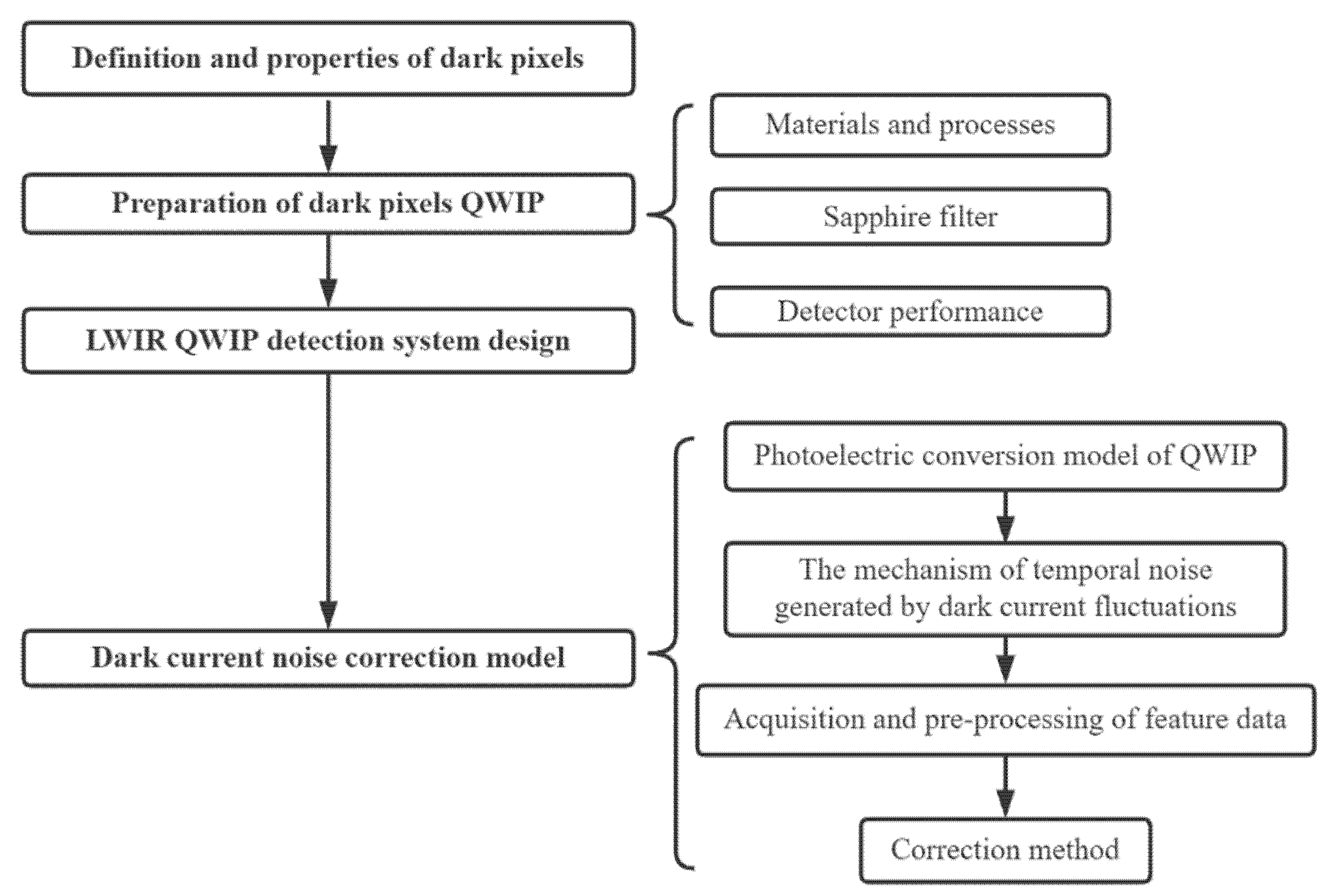

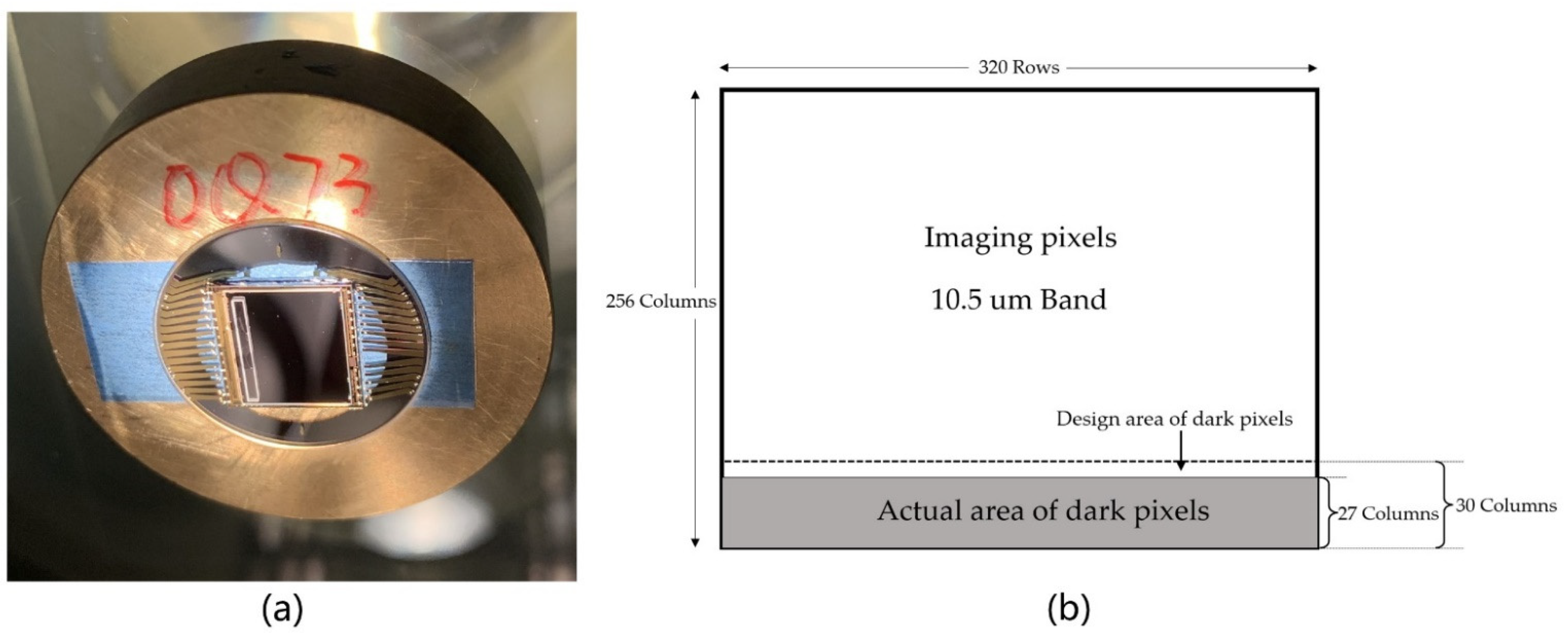

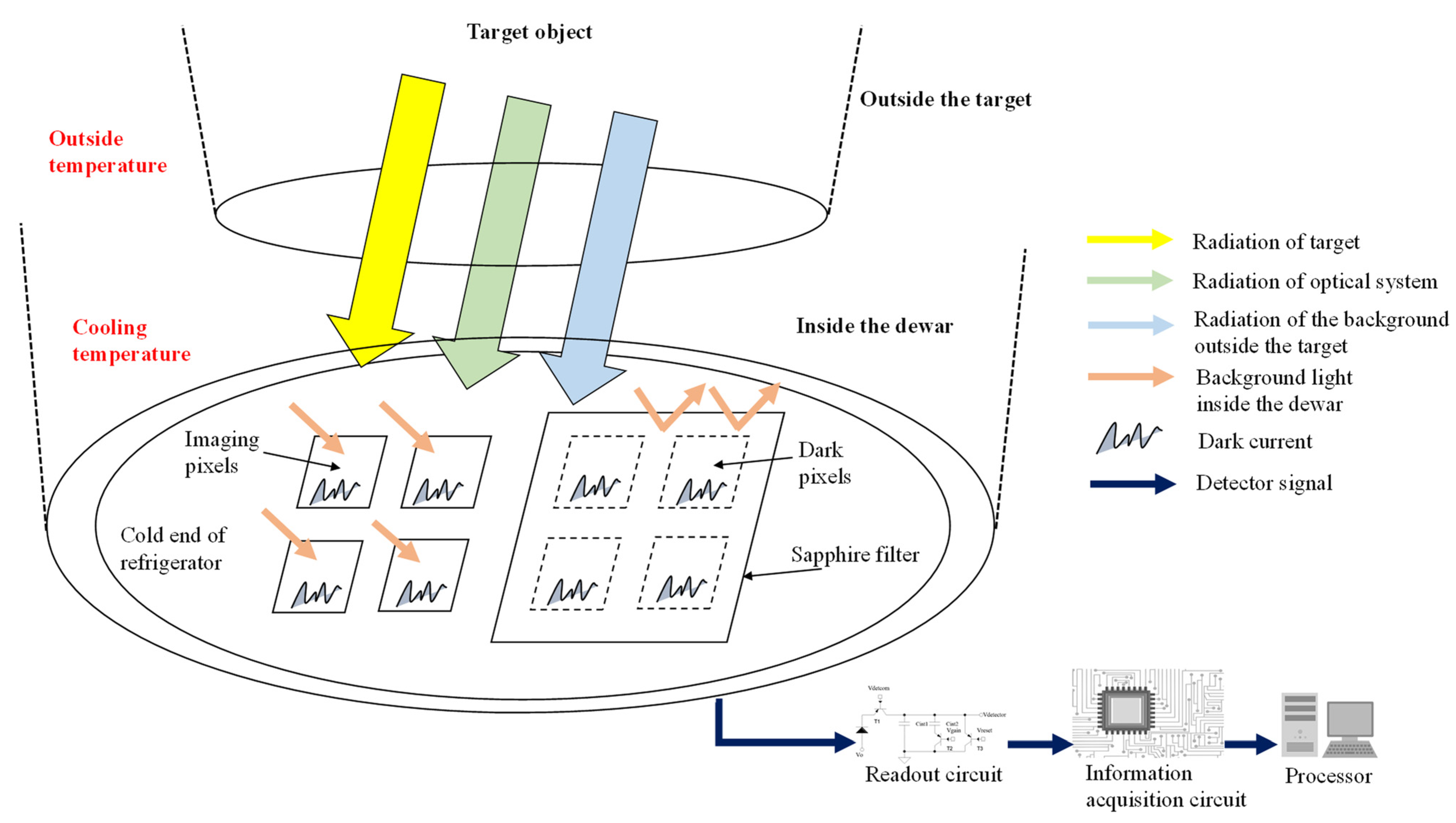

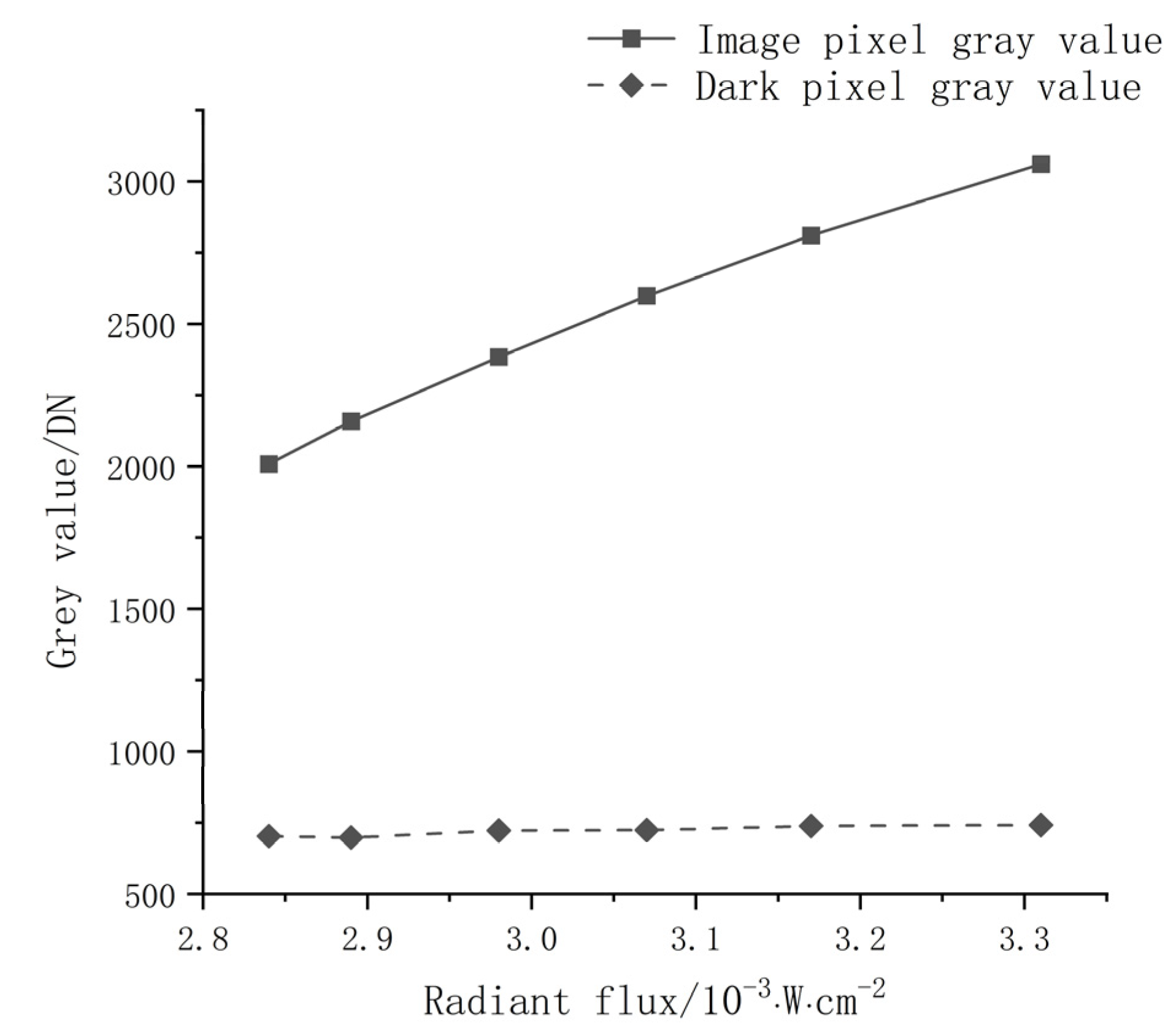
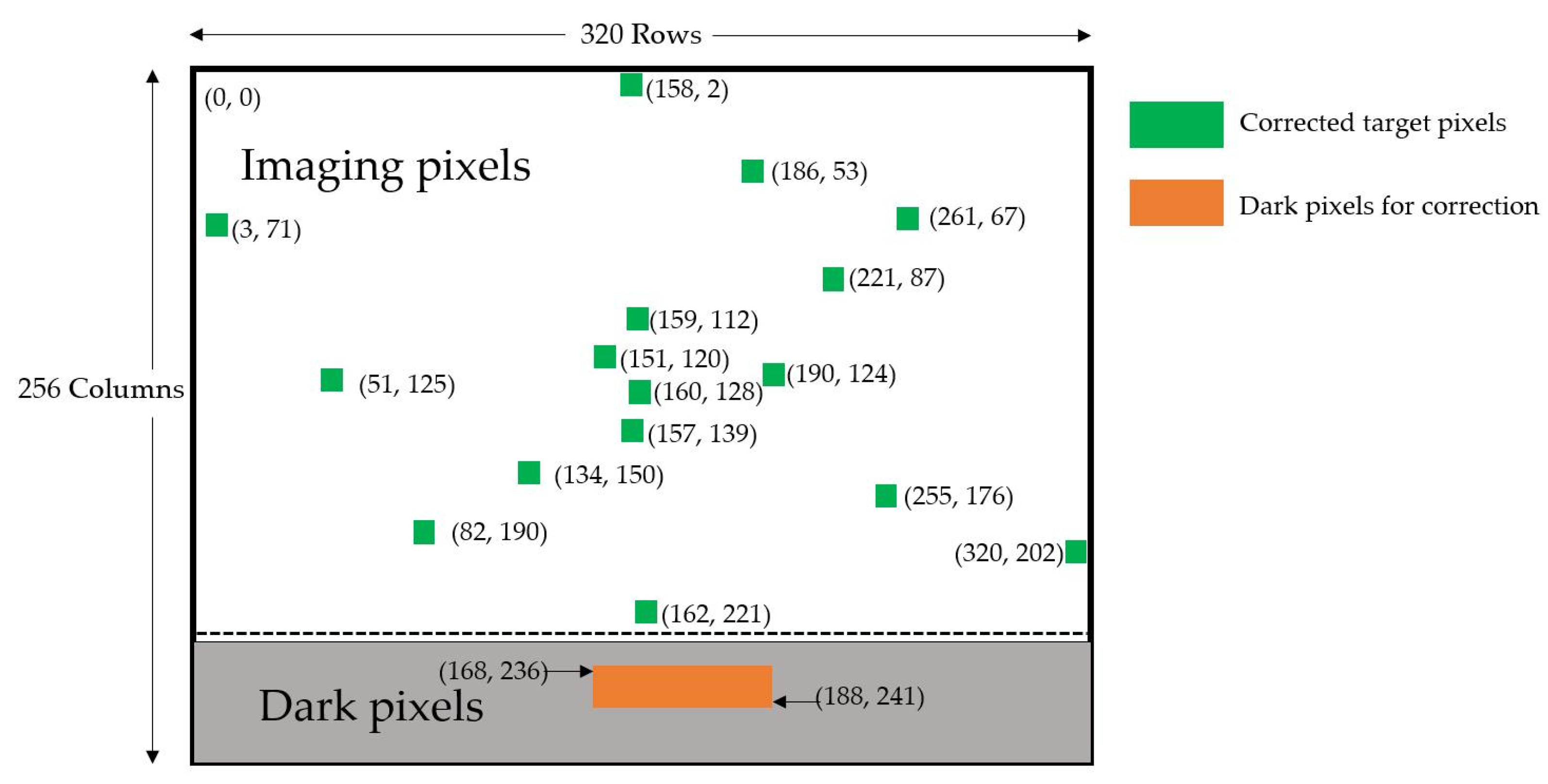
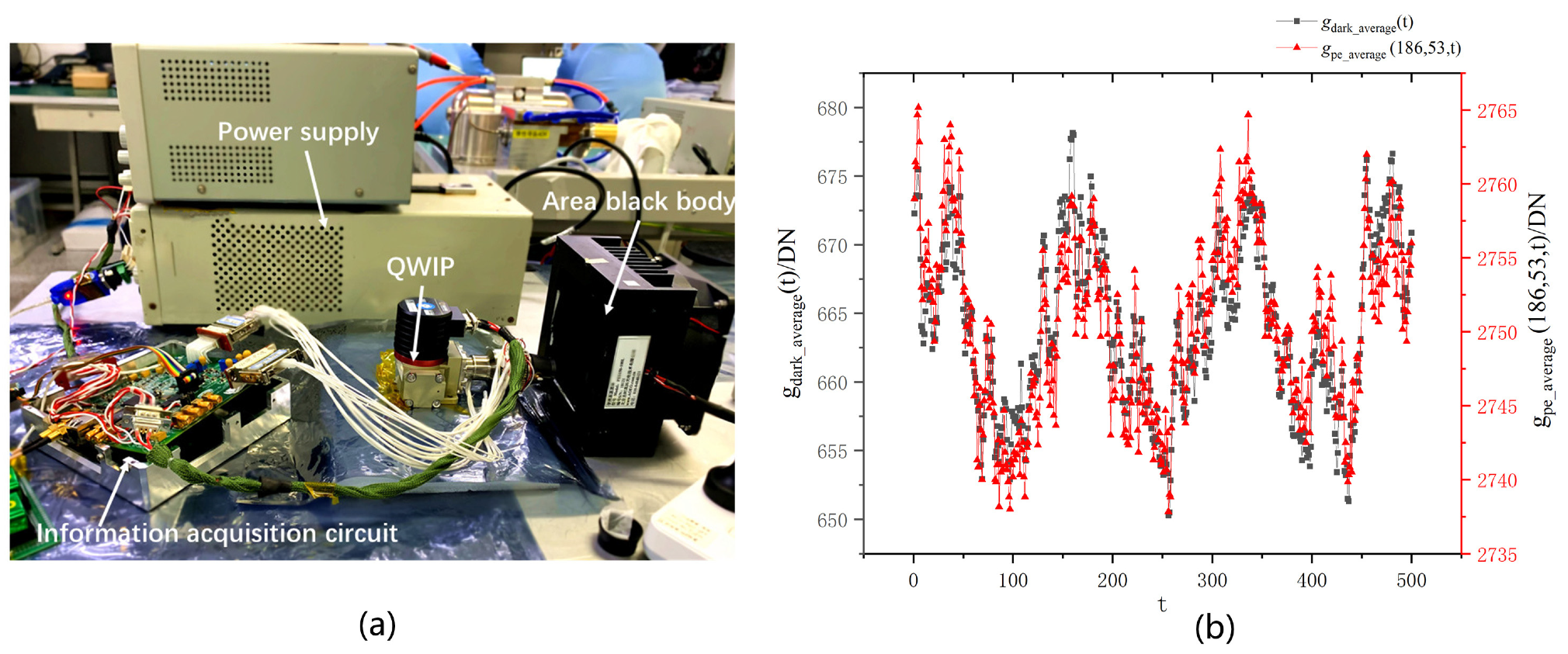

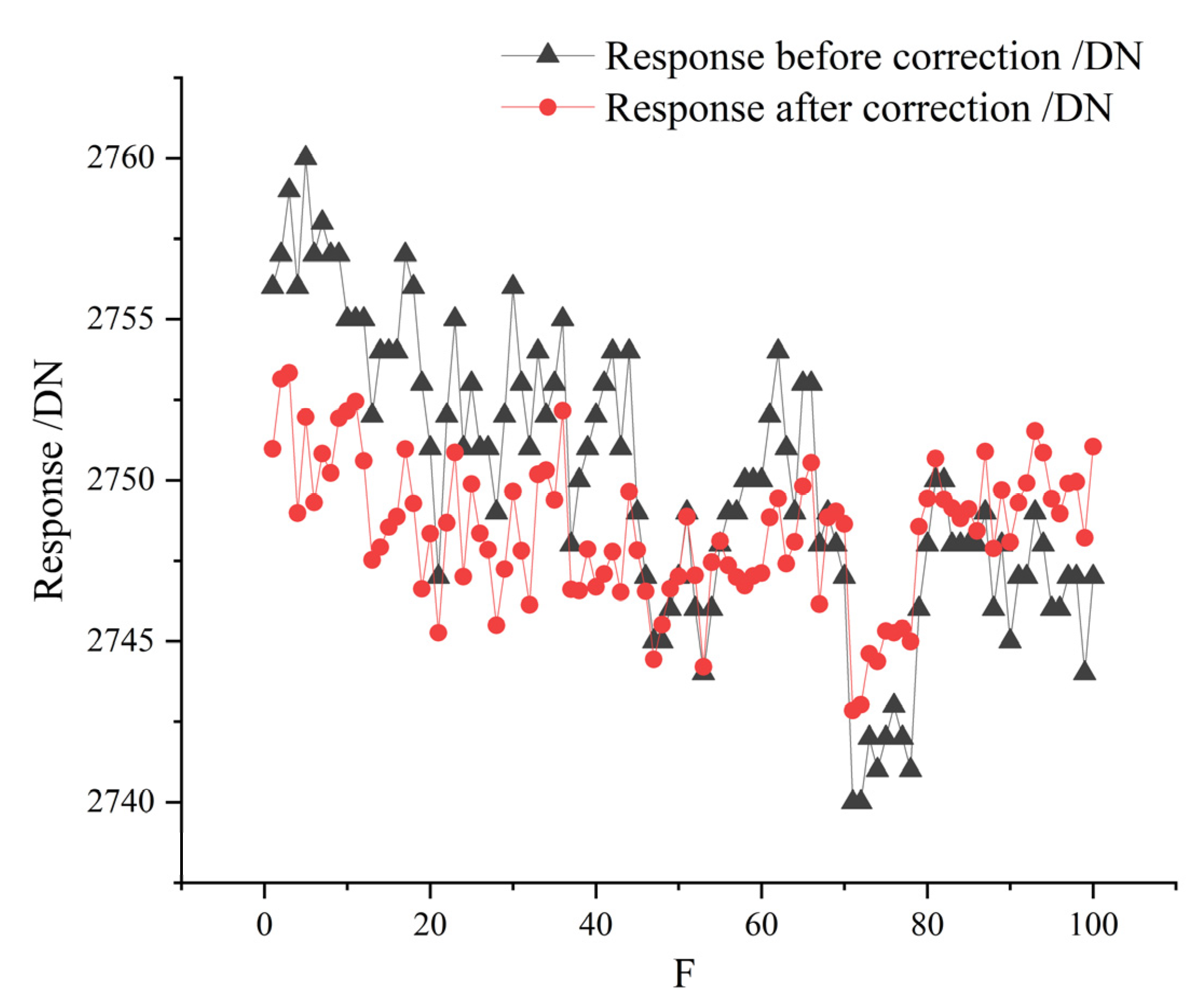
| Detector Parameters | Parameter Values |
|---|---|
| Array size | 320 × 256 |
| Pitch/um | 30 |
| f-number | 2.0 |
| Peak wavelength/um | 10.5 |
| Response bandwidth/um | ≥1.0 |
| Blind pixel rate | 0.75% |
| Noise-Equivalent Temperature Difference/mK | 34.5 |
| Non-uniformity | 4.35% |
| Cooling temperature/K | 50 |
| Frame rate/Hz | 20 |
| Pixel Coordinates/(i, j) | Temporal Noise Before Correction | Temporal Noise After Correction | Noise Reduction Ratio | |
|---|---|---|---|---|
| Center | (159, 112) | 4.05 | 2.02 | 50.37% |
| (151, 120) | 3.94 | 2.01 | 48.98% | |
| (157, 139) | 3.92 | 2.05 | 47.70% | |
| (160, 128) | 4.21 | 2.10 | 50.11% | |
| Edge | (3, 71) | 4.13 | 2.11 | 48.91% |
| (158, 2) | 3.98 | 2.03 | 48.99% | |
| (320, 202) | 4.32 | 2.12 | 50.93% | |
| (162, 221) | 4.01 | 2.03 | 49.38% | |
| Other | (186, 53) | 4.42 | 2.17 | 50.90% |
| (51, 125) | 3.96 | 2.01 | 49.24% | |
| (261, 67) | 3.83 | 2.10 | 45.17% | |
| (190, 124) | 4.18 | 2.02 | 51.67% | |
| (255, 176) | 4.08 | 2.11 | 48.28% | |
| (82, 190) | 4.08 | 2.04 | 50.00% | |
| (134, 150) | 4.19 | 2.17 | 48.21% | |
| (221, 87) | 4.60 | 2.40 | 47.83% | |
| Temperature of the Target/k | 296 | 298 | 300 | 305 |
| Noise Reduction Ratio | 48.82% | 49.17% | 49.30% | 48.79% |
Publisher’s Note: MDPI stays neutral with regard to jurisdictional claims in published maps and institutional affiliations. |
© 2022 by the authors. Licensee MDPI, Basel, Switzerland. This article is an open access article distributed under the terms and conditions of the Creative Commons Attribution (CC BY) license (https://creativecommons.org/licenses/by/4.0/).
Share and Cite
Du, H.; Xu, J.; Yin, Z.; Chai, M.; Sun, D. Dark Current Noise Correction Method Based on Dark Pixels for LWIR QWIP Detection Systems. Appl. Sci. 2022, 12, 12967. https://doi.org/10.3390/app122412967
Du H, Xu J, Yin Z, Chai M, Sun D. Dark Current Noise Correction Method Based on Dark Pixels for LWIR QWIP Detection Systems. Applied Sciences. 2022; 12(24):12967. https://doi.org/10.3390/app122412967
Chicago/Turabian StyleDu, Haoting, Jintong Xu, Zihao Yin, Mengyang Chai, and Dexin Sun. 2022. "Dark Current Noise Correction Method Based on Dark Pixels for LWIR QWIP Detection Systems" Applied Sciences 12, no. 24: 12967. https://doi.org/10.3390/app122412967






